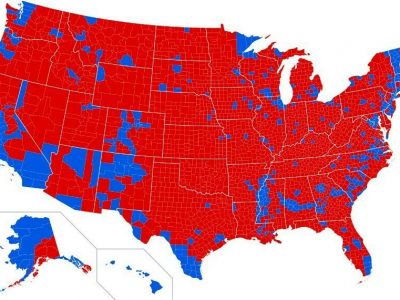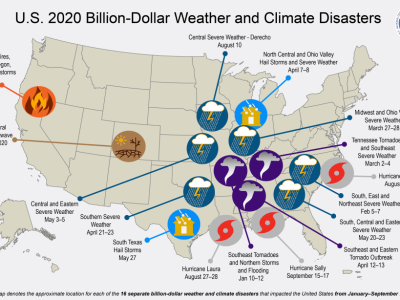Agriculture As A Climate Solution
New CLEE / Berkeley Food Institute report on how to promote regenerative agriculture
The climate fight should ultimately benefit all communities, just as they are all part of the solution. Agricultural communities are no exception. Farmers and ranchers can implement climate-friendly techniques that both sequester carbon and boost profits and long-term sustainability (sometimes referred to as “regenerative agriculture”). Examples of these practices include crop diversification and rotation, cover cropping, low-to-no tillage, rangeland and cropland co...
CONTINUE READINGNext Steps to Save the Global Environment
A lot will need to be done to undo Trump’s harm to global cooperation. Here’s a start.
Trump’s hostility domestic environmental regulation is notorious. He also stalled or backpedaled on the international front. Here are seven steps that President Biden could take to remedy the situation. Rejoin the Paris Agreement. The U.S. needs to immediately rejoin the Paris Agreement. It also needs to update its climate target, because we can do a lot more than we thought possible even four years ago to reduce emissions. Technology has improved, ren...
CONTINUE READINGThe Georgia Elections, the Republican Schism, and the Environment
The prospects for a green stimulus bill have improved
Although the word is overused, last week really did see a seismic shift in the political world. Actually, there were two earthquakes — the victories of Democrats Warnock and Ossoff in Georgia, and the violent invasion of the U.S. capitol incited by Trump. While the significance of these events is much broader, their relevance to environmental and energy issues should not be overlooked. Basically, Biden’s hand in Congress has just gotten stronger, and a green stim...
CONTINUE READINGClimate Politics and the Urban-Rural Split
How do we sell climate policies to huge swathes of Trump country?
The 2020 elections revealed America as bitterly divided as ever. The split between rural and urban voters is intensifying, with rural voters delivering massive support to Trump and down ticket Republicans. Success in decarbonizing the economy will ultimately require the support of those voters. Short of a miraculous turnaround in attitudes about climate change, how can we get them on board? Part of the answer lies in disaggregating climate policies. A sweeping n...
CONTINUE READINGThe Year Ahead
Nine key developments to watch for on the environmental front.
2020 was a tumultuous year. Hopefully, 2021 will be balmier. Widespread use of vaccines will hopefully tame the COVID-19 pandemic, and maybe the political world will settle down a bit too. Here are nine key things to watch for in terms of environmental policy. The Georgia runoff elections. Currently, the Republicans look likely to control the Senate. But two seats are still in play, due to runoff elections in Georgia tomorrow. If Democrats manage to take those...
CONTINUE READINGThe California Supreme Court’s Most Important Environmental Law Decisions of 2020
It Was a Relatively Quiet Year for Environmental Law in the California Supreme Court
[This is the third and final installment in a series of posts highlighting the most significant environmental law decisions of 2020. Earlier this week, I profiled the key 2020 environmental rulings by the U.S. Supreme Court and the U.S. Court of Appeals for the Ninth Circuit. This post concludes the series with an examination of the California Supreme Court's most consequential environmental law decisions this year.] Truth be told, 2020 was an atypically light...
CONTINUE READINGThe Clean Air Act Turns Fifty
A half century of progress in cleaning up the air began New Year’s Eve 1970.
On December 31, 1970, President Richard M. Nixon signed the Clean Air Act. William Ruckelshaus and Russell Train, who later led the way in implementing the new law, stood by his side with beaming smiles. Nixon supported the basic features of the bill. But he had considered vetoing the final version because Senator Ed Muskie (D Maine) had added tough pollution requirements for carmakers. Aides persuaded him to sign it instead and seek later amendments. After some m...
CONTINUE READINGThe Ninth Circuit’s 10 Most Important Environmental Law Decisions of 2020
Climate Change, California v. Trump Cases Lead the List
This is the second of three year-end posts on the most important environmental law decisions in 2020 from the U.S. Supreme Court, U.S. Court of Appeals for the Ninth Circuit and California Supreme Court. (The key U.S. Supreme Court rulings were the focus of yesterday's post, and tomorrow's will feature California Supreme Court decisions.) Today, the spotlight is on the Ninth Circuit. Selecting the top 10 most important environmental law decisions of 2020 from the ...
CONTINUE READINGThe U.S. Supreme Court’s Most Important 2020 Environmental Law Decisions
Clean Water Act, CERCLA, Native American Law and Trump's Border Wall Lead the List
It's become customary for critics and observers from many disciplines to publish a wide variety of lists at year's end, nominating the most important or best movies, music, plays, etc. of the preceding year. Why not follow that tradition in the fields of environmental law and policy? With that objective in mind, I plan over the next few days to offer my lists of the most consequential environmental law decisions of 2020 from the U.S. Supreme Court, the U.S. Court of...
CONTINUE READING2020: The Year in Review
Trump's deregulatory reign of terror continued, but there were still some bright spots.
In terms of the environment, the big news was the election. Biden swept the popular vote and won a solid victor in the Electoral College. At this point, the Republicans have retained control of the Senate, though runoff elections in Georgia could change that. On another front, US carbon emissions were down for the year, due to COVID, although that’s expected to be temporary. To the extent that people end up using Zoom to work at home or to substitute for busines...
CONTINUE READING








